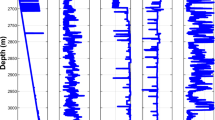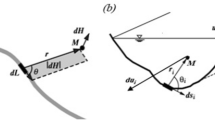Abstract
Currently made alternative structures from loose stones, gabion weirs are preferred with respect to solid concrete weirs formerly used in the past. By being more stable and flexible, gabion weirs have great advantage over their rigid (impervious) counterparts. The aim of this study was to investigate the overflow and through flow in rectangular broad-crested gabion weirs in order to evaluate the discharge coefficient C d. Eight physical models of broad-crested gabion weirs with four different porosities were made. The results of the experiments revealed that C d tended to be 20% less in submerged flow than in free flow. In addition, the average values of C d in both free and submerged flow were 0.66 and 0.53, respectively. Though increasing the gabion porosity led to an increase in C d, this amount became less and less with higher discharge values. M5 tree model as a sub-technique of data mining used to model C d values is capable of constructing tree-based piecewise linear equations for continuous datasets. The results showed that M5 tree model presents 12 linear equations for both free and submerged flows with R and RMSE of 0.95 and 0.036, respectively.








Similar content being viewed by others
Abbreviations
- B :
-
Weir width
- d 50 :
-
Mean stone size used in gabion construction
- Fr :
-
Froude number = \(\frac{q}{{\sqrt g H_{1}^{1.5} }}\)
- G :
-
Acceleration due to gravity
- H 1 :
-
Water depth in upstream of the weir measured from weir crest
- H 2 :
-
Water depth in downstream of the weir measured from weir crest
- L :
-
Weir length
- n :
-
Porosity of gabion materials
- P :
-
Weir height
- Q :
-
Discharge
- q :
-
Discharge per unit width
- Re :
-
Reynolds number
- S r :
-
Submergence ration = H 2/H 1
- ρ :
-
Fluid density
- μ :
-
Dynamic viscosity of the fluid (water)
References
Ditthakit P, Chinnarasri C (2012) Estimation of pan coefficient using M5 model tree. Am J Environ Sci 8(2):95–103
Gogos M, Defne Z, Ozkandemir V (2006) Broad-crested weirs with rectangular compound cross sections. J Irrig Drain Eng 132(3):272–280
Gonzalez CA, Chanson H (2007) Experimental measurements of velocity and pressure distributions on a large broad-crested weir. Flow Meas Instrum 18(3–4):107–113
Hager WH, Schwalt M (1994) Broad-crested weir. J Irrig Drain Eng 120(1):13–26
Kells JA (1993) Spatially varied flow over rock fill embankments. Can J Civ Eng 20:820–827
Kells JA (1994) Reply on discussion of spatially varied flow over rockfill embankments. Can J Civ Eng 21:163–166
Londhe SN, Dixit PR (2011) Forecasting stream flow using model trees. Int J Earth Sci Eng 4(6):282–285
Michioku K, Maeno S, Furusawa T, Haneda M (2005) Discharge through a permeable rubble mound weir. J Hydral Eng 131(1):1–10
Michioku K, Maeno S, Etoh T (2007) An experimental study on flow field in and around rubble mound river structures. J Hydrosci Hydraul Eng 25(2):37–45
Mohamed H (2010) Flow over gabion weirs. J Irrig Drain Eng 136(8):573–577. doi:10.1061/(ASCE)IR.1943-4774.0000215
Pal M, Deswal S (2009) M5 model tree based modeling of reference evapotranspiration. Hydrol Process 23(10):1437–1443
Pal M, Singh NK, Tiwari NK (2012) M5 model tree for pier scour prediction using field dataset. KSCE J Civ Eng 16(6):1079–1084
Quinlan JR (1992) Learning with continuous classes. In: Adams A, Sterling L (eds) Proceedings of fifth Australian joint conference on artificial intelligence. World Scientific, Singapore, pp 343–348
Ramamurthy SA, Tim US, Rao MV (1998) Characteristics of square-edged and round-nosed broad-crested weirs, ASCE. J Irrig Drain Eng 114(1):61–73
Salmasi F, Poorescandar S, Hosseinzadeh Dalir A, Farsadi Zadeh D (2011) Discharge relations for rectangular broad-crested weirs. J Agric Sci 17:324–336
Salmasi F, Cahamani MR, Farsadi Zadeh D (2012) Study of energy dissipation over stepped gabion spillways with low heights. Iran J Sci Technol Trans B Eng Civ Eng 36(C2):253–264
Salmasi F, Yıldırım G, Masoodi A, Parsamehr P (2013) Predicting discharge coefficient of compound broad-crested weir by using genetic programming (GP) and artificial neural network (ANN) techniques. Arab J Geosci 6:2709–2717. doi:10.1007/s12517-012-0540-7
Sarker MA, Rhodes DG (2004) Calculation of free-surface profile over a rectangular broad-crested weir. Flow Meas Instrum 15(4):215–219
Sattari MT, Pal M, Apaydin H, Ozturk F (2013a) M5 model tree application in daily river flow forecasting in Sohu stream, Turkey. Water Resour 40(3):233–242
Sattari MT, Pal M, Yurekli K, Ünlukara A (2013b) M5 model trees and neural network based modeling of ET0 in Ankara, Turkey. Turk J Eng Environ Sci. doi:10.3906/muh-1212-5
Witten IH, Frank E (2005) Data mining: practical machine learning tools and techniques with Java implementations. Morgan Kaufmann, San Francisco
Author information
Authors and Affiliations
Corresponding author
Rights and permissions
About this article
Cite this article
Salmasi, F., Sattari, M.T. Predicting Discharge Coefficient of Rectangular Broad-Crested Gabion Weir Using M5 Tree Model. Iran J Sci Technol Trans Civ Eng 41, 205–212 (2017). https://doi.org/10.1007/s40996-017-0052-5
Received:
Accepted:
Published:
Issue Date:
DOI: https://doi.org/10.1007/s40996-017-0052-5




